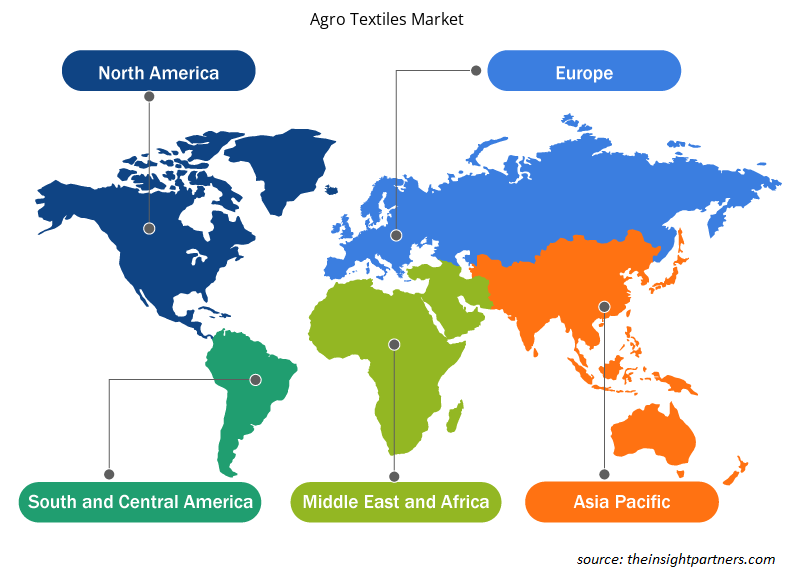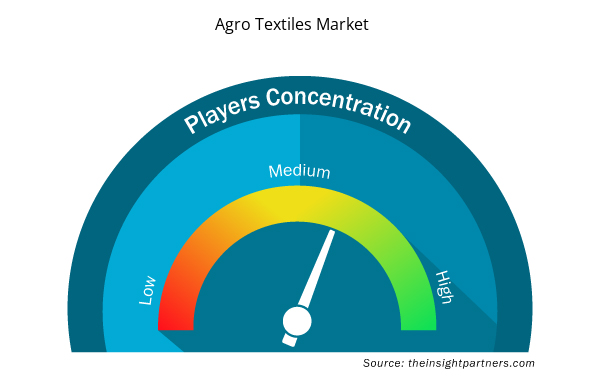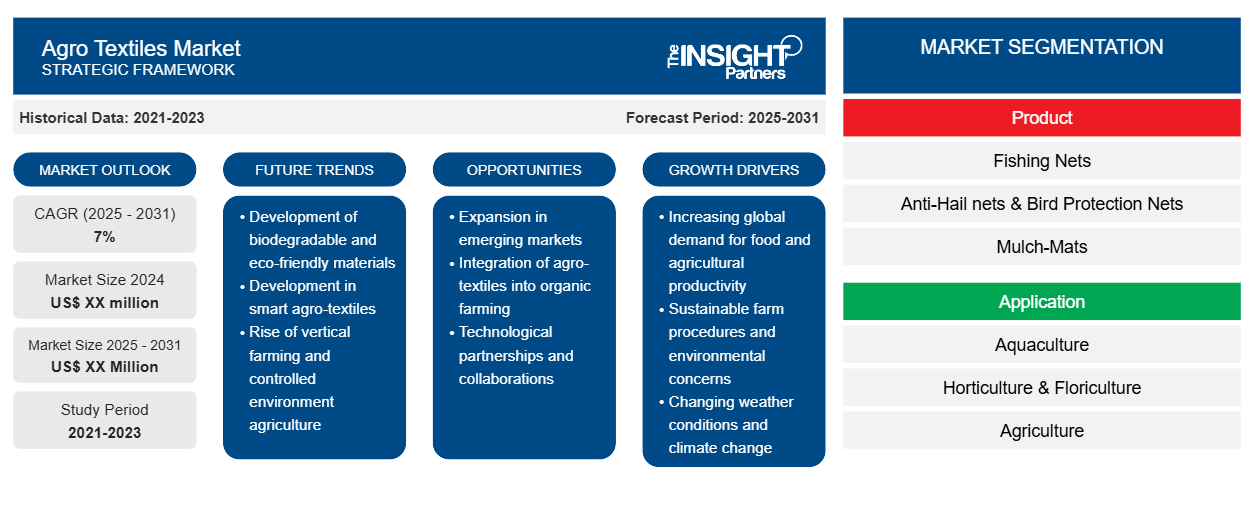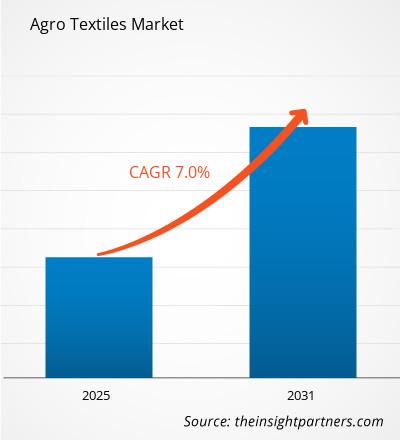Si prevede che il mercato agrotessile registrerà un CAGR del 7% dal 2023 al 2031, con una dimensione di mercato in espansione da XX milioni di dollari nel 2023 a XX milioni di dollari entro il 2031.
Il report è segmentato per prodotto (reti da pesca, reti antigrandine e reti di protezione per uccelli, pacciamatura, reti ombreggianti e altri). Il report presenta inoltre analisi basate sull'applicazione (acquacoltura, orticoltura e floricoltura, agricoltura e altri). L'analisi globale è ulteriormente suddivisa a livello regionale e per i principali paesi. Le dimensioni del mercato e le previsioni a livello globale, regionale e nazionale per tutti i principali segmenti di mercato sono coperte nell'ambito. Il report offre il valore in USD per l'analisi e i segmenti di cui sopra. Il report fornisce statistiche chiave sullo stato di mercato dei principali attori del mercato e offre tendenze e opportunità di mercato.
Scopo del rapporto
Il report Agro Textiles Market di The Insight Partners mira a descrivere il panorama attuale e la crescita futura, i principali fattori trainanti, le sfide e le opportunità. Ciò fornirà spunti a vari stakeholder aziendali, come:
- Fornitori/produttori di tecnologia: per comprendere le dinamiche di mercato in evoluzione e conoscere le potenziali opportunità di crescita, consentendo loro di prendere decisioni strategiche informate.
- Investitori: condurre un'analisi completa delle tendenze in merito al tasso di crescita del mercato, alle proiezioni finanziarie del mercato e alle opportunità esistenti lungo la catena del valore.
- Enti di regolamentazione: regolamentano le politiche e le attività di controllo sul mercato allo scopo di ridurre al minimo gli abusi, preservare la fiducia degli investitori e sostenere l'integrità e la stabilità del mercato.
Segmentazione del mercato agro-tessile
Prodotto
- Reti da pesca
- Reti antigrandine e reti di protezione uccelli
- Stuoie di pacciamatura
- Reti ombreggianti
Applicazione
- Acquacoltura
- Orticoltura e Floricoltura
- Agricoltura
Personalizza questo report in base alle tue esigenze
Riceverai la personalizzazione gratuita di qualsiasi report, comprese parti di questo report, o analisi a livello nazionale, pacchetto dati Excel, oltre a usufruire di grandi offerte e sconti per start-up e università
- Scopri le principali tendenze di mercato in questo rapporto.Questo campione GRATUITO includerà analisi di dati che spaziano dalle tendenze di mercato alle stime e alle previsioni.
Fattori trainanti della crescita del mercato agro-tessile
- Aumento della domanda globale di cibo e produttività agricola: la domanda globale di cibo aumenta ed è quindi uno dei principali motori del mercato agro-tessile. La popolazione è in crescita; quindi, la domanda di una maggiore produttività agricola continua ad aumentare. Gli agro-tessili come reti, materiali ombreggianti e pellicole pacciamanti aiutano a ottimizzare la produzione delle colture proteggendole da parassiti, malattie e condizioni meteorologiche estreme. Sono anche utilizzati per regolare la temperatura e l'umidità per creare un ambiente che possa supportare la crescita delle piante. Questa condizione è ciò che determina l'adozione degli agro-tessili, affermandoli in tutto il mondo.
- Procedure agricole sostenibili e preoccupazioni ambientali: con la sostenibilità che sta gradualmente diventando il mantra dell'agricoltura, gli agrotessili stanno iniziando a essere visti sotto la luce verde. Ad esempio, i teli di pacciamatura biodegradabili stanno sostituendo i teli di pacciamatura in plastica convenzionali, riducendo così i rifiuti di plastica nei campi agricoli. Come parte di un'agricoltura efficiente in termini di risorse, questi agrotessili, integrati da reti per il controllo dei parassiti e tessuti ombreggianti, mirano a ridurre la dipendenza da quei pesticidi e fertilizzanti chimici, il cui uso danneggia l'ambiente. Con l'aumento della domanda di un'agricoltura ecosostenibile, le nozioni vanno agli agrotessili per stabilirli come valide alternative per un'agricoltura efficiente in termini di risorse.
- Condizioni meteorologiche mutevoli e cambiamenti climatici: i cambiamenti climatici continuano a minare la regolarità e l'intensità dei modelli o fenomeni meteorologici, tra cui siccità, inondazioni e temperature estreme. La soluzione importante per prevenire tali morti ambientali è costituita da agrotessili o reti protettive, teli ombreggianti, coperture resistenti alle intemperie e così via. Tali strutture possono fungere da dispositivi di protezione per condizioni ambientali avverse, mantenendo l'umidità del suolo e regolando la temperatura. L'aumento dell'incidenza di condizioni meteorologiche estreme, pertanto, significa che gli agrotessili saranno sempre più richiesti, offrendo approcci innovativi molto coltivabili per rispondere alla variabilità climatica.
Tendenze future del mercato agro-tessile
- Sviluppo di materiali biodegradabili ed ecocompatibili: lo sviluppo sostenibile è diventato uno degli argomenti più vitali in agricoltura al momento e dominerà sicuramente il futuro mercato agro-tessile mondiale. Si prevede che "presto" entrerà nel giro delle industrie agro-tessili che si stanno muovendo verso materiali biodegradabili ed ecocompatibili. L'intero settore ha sperimentato una crescente consapevolezza del fatto che tali agro-tessili biodegradabili, pellicole per schermatura e pacciamatura, reti prodotte da fibre naturali o polimeri biodegradabili, sono di valore perché ridurrebbero quasi automaticamente l'impatto ambientale delle operazioni agricole. Riducono l'accumulo di rifiuti di plastica decomponendosi ulteriormente lungo la linea dopo averli utilizzati durante la produzione. Si ritiene che il continuo sviluppo e l'adozione di tali agro-tessili influenzerebbero notevolmente il mercato.
- Sviluppo di agrotessili intelligenti: un altro effetto significativo sul futuro del mercato è l'inclusività tecnologica negli agrotessili. Gradualmente, gli agrotessili intelligenti, o tessuti in grado di rilevare e reagire ai cambiamenti delle condizioni ambientali, saranno sempre più utilizzati. Questi tipi di indumenti saranno progettati con sensori che misurano l'umidità e la temperatura nel terreno, nonché dati relativi ai parassiti, consentendo agli agricoltori di valutare la necessità di irrigazione e controllo dei parassiti in base alle prestazioni delle colture. Per quanto riguarda l'agricoltura di precisione e l'agricoltura digitale, si può sospettare che tale integrazione non farà che rafforzarsi man mano che gli agrotessili intelligenti diventeranno più comuni.
- Ascesa dell'agricoltura verticale e dell'agricoltura in ambiente controllato: tali cambiamenti nell'ambiente dovuti alle correnti controllate dall'agricoltura gettano nuove prospettive negli agrotessili a livello globale. Con l'aumento dell'urbanizzazione e la diminuzione dei terreni arabili, l'agricoltura verticale, ovvero la coltivazione di vegetazione in strati sovrapposti o in ambienti controllati, diventa una realtà per la maggior parte. Gli agrotessili, tra cui pellicole riflettenti, materiali anti-UV e tessuti termoregolatori, contribuiscono tutti a questi sistemi creando le condizioni di crescita ottimali. Con una sempre maggiore accettazione di questi sistemi di coltivazione, ci sarà una richiesta di agrotessili più specializzati, realizzati specificamente per l'uso nell'agricoltura verticale e nell'agricoltura in ambiente controllato.
Opportunità di mercato dell'agro-tessile
- Espansione nei mercati emergenti: questo è certamente vero, poiché mentre Asia-Pacifico, Africa e America Latina stanno attraversando delle transizioni, offrono il potenziale più grande per il mercato agro-tessile globale. La maggior parte di questi paesi dipende dall'agricoltura e ora si sta rivolgendo agli agro-tessili per migliorare la resa delle colture e per altri shock climatici per gli agricoltori. Si prevede che una maggiore domanda di agro-tessili deriverà dalla cultura accresciuta dell'agricoltura moderna verso pratiche sostenibili da parte degli agricoltori, specialmente in queste aree. Il governo che incoraggia e sovvenziona pratiche agricole sostenibili e la sicurezza alimentare nelle economie in via di sviluppo tende a promuovere ulteriormente la crescita del mercato.
- Integrazione degli agrotessili nell'agricoltura biologica: oggigiorno, l'agricoltura biologica sta rapidamente prendendo piede per la sua popolarità tra i consumatori che hanno sviluppato una consapevolezza molto più elevata dell'uso di pesticidi negli alimenti e, di conseguenza, un'inclinazione verso i prodotti biologici. Le altre funzioni primarie degli agrotessili nell'agricoltura biologica sono il controllo dei parassiti, la protezione del suolo e la ritenzione di umidità delle colture senza sostanze chimiche. Questa crescente pratica dell'agricoltura biologica in tutto il mondo è la principale opportunità per il mercato agrotessile. L'aumento dell'agricoltura biologica aumenterebbe la domanda di agrotessili per l'agricoltura biologica. Ciò rappresenterebbe una nicchia considerevole per i produttori di ecotessili.
- Partnership e collaborazioni tecnologiche: questa è ancora una delle principali opportunità di mercato per i produttori di agro-tessili e gli sviluppatori di tecnologie. L'integrazione di nuovi materiali, come tessuti intelligenti e tessuti con nano-rivestimento, arricchirebbe anche le funzionalità e le prestazioni agro-tessili. Tali collaborazioni potrebbero creare tessuti in grado di trattenere un'elevata capacità di ritenzione idrica, fornire protezione UV e dotati di sensori per un migliore monitoraggio delle colture tramite aziende tecnologiche. Queste partnership di produttori tessili e aziende tecnologiche fungeranno da importante via per l'innovazione e l'espansione del mercato man mano che la domanda di agro-tessili multifunzionali e ad alta tecnologia si intensifica.
Approfondimenti regionali sul mercato agro-tessile
Le tendenze regionali e i fattori che influenzano il mercato agro-tessile durante il periodo di previsione sono stati ampiamente spiegati dagli analisti di Insight Partners. Questa sezione discute anche i segmenti e la geografia del mercato agro-tessile in Nord America, Europa, Asia Pacifico, Medio Oriente e Africa, e Sud e Centro America.

- Ottieni i dati specifici regionali per il mercato agro-tessile
Ambito del rapporto sul mercato agro-tessile
| Attributo del report | Dettagli |
|---|---|
| Dimensioni del mercato nel 2023 | XX milioni di dollari USA |
| Dimensioni del mercato entro il 2031 | XX milioni di dollari USA |
| CAGR globale (2023-2031) | 7% |
| Dati storici | 2021-2022 |
| Periodo di previsione | 2024-2031 |
| Segmenti coperti | Per Prodotto
|
| Regioni e Paesi coperti | America del Nord
|
| Leader di mercato e profili aziendali chiave |
|
Densità degli attori del mercato agro-tessile: comprendere il suo impatto sulle dinamiche aziendali
Il mercato Agro Textiles Market sta crescendo rapidamente, spinto dalla crescente domanda degli utenti finali dovuta a fattori quali l'evoluzione delle preferenze dei consumatori, i progressi tecnologici e una maggiore consapevolezza dei benefici del prodotto. Con l'aumento della domanda, le aziende stanno ampliando le loro offerte, innovando per soddisfare le esigenze dei consumatori e capitalizzando sulle tendenze emergenti, il che alimenta ulteriormente la crescita del mercato.
La densità degli operatori di mercato si riferisce alla distribuzione di aziende o società che operano in un particolare mercato o settore. Indica quanti concorrenti (operatori di mercato) sono presenti in un dato spazio di mercato in relazione alle sue dimensioni o al valore di mercato totale.
Le principali aziende che operano nel mercato agrotessile sono:
- Tama
- SRF limitata
- Industrie Belton
- Tessuti tecnici Beaulieu
Disclaimer : le aziende elencate sopra non sono classificate secondo un ordine particolare.

- Ottieni una panoramica dei principali attori del mercato agro-tessile
Punti di forza chiave
- Copertura completa: il rapporto esamina in modo completo i prodotti, i servizi, le tipologie e gli utenti finali del mercato agrotessile, offrendo una panoramica olistica.
- Analisi degli esperti: il rapporto è compilato sulla base della conoscenza approfondita di esperti e analisti del settore.
- Informazioni aggiornate: il rapporto garantisce la pertinenza aziendale grazie alla copertura di informazioni recenti e tendenze nei dati.
- Opzioni di personalizzazione: questo report può essere personalizzato per soddisfare le esigenze specifiche del cliente e adattarsi in modo appropriato alle strategie aziendali.
Il rapporto di ricerca sul mercato agro-tessile può quindi aiutare a guidare il percorso di decodificazione e comprensione dello scenario del settore e delle prospettive di crescita. Sebbene possano esserci alcune preoccupazioni valide, i vantaggi complessivi di questo rapporto tendono a superare gli svantaggi.
- Analisi storica (2 anni), anno base, previsione (7 anni) con CAGR
- Analisi PEST e SWOT
- Valore/volume delle dimensioni del mercato - Globale, regionale, nazionale
- Industria e panorama competitivo
- Set di dati Excel



Report Coverage
Revenue forecast, Company Analysis, Industry landscape, Growth factors, and Trends

Segment Covered
This text is related
to segments covered.

Regional Scope
North America, Europe, Asia Pacific, Middle East & Africa, South & Central America

Country Scope
This text is related
to country scope.
Domande frequenti
Smart and responsive textiles is expected to be the key market trends
Based on geography, Asia Pacific held the largest share of the agro textiles market due to the well-established agriculture industry across the region, coupled with continuous growth and development
Based on product, the mulch-mats segment is expected to witness the fastest growth during the forecast period
Tama;SRF Limited;Belton Industries;Beaulieu Technical Textiles;Diatex;Meyabond Industry & Trading (Beijing)Co., Ltd.;Zhongshan Hongjun Nonwoven Co., Ltd.;Hy-Tex (UK) Limited;CAPATEX LTD;B&V Agro Irrigation Co
Increasing demand for food security is driving the market growth
The Agro Textiles Market is estimated to witness a CAGR of 7% from 2023 to 2031
Trends and growth analysis reports related to Chemicals and Materials : READ MORE..
The List of Companies
1. Tama
2. SRF Limited
3. Belton Industries
4. Beaulieu Technical Textiles
5. Diatex
6. Meyabond Industry & Trading (Beijing) Co., Ltd.
7. Zhongshan Hongjun Nonwoven Co., Ltd.
8. Hy-Tex (UK) Limited
9. CAPATEX LTD
10. B&V Agro Irrigation Co
The Insight Partners performs research in 4 major stages: Data Collection & Secondary Research, Primary Research, Data Analysis and Data Triangulation & Final Review.
- Data Collection and Secondary Research:
As a market research and consulting firm operating from a decade, we have published and advised several client across the globe. First step for any study will start with an assessment of currently available data and insights from existing reports. Further, historical and current market information is collected from Investor Presentations, Annual Reports, SEC Filings, etc., and other information related to company’s performance and market positioning are gathered from Paid Databases (Factiva, Hoovers, and Reuters) and various other publications available in public domain.
Several associations trade associates, technical forums, institutes, societies and organization are accessed to gain technical as well as market related insights through their publications such as research papers, blogs and press releases related to the studies are referred to get cues about the market. Further, white papers, journals, magazines, and other news articles published in last 3 years are scrutinized and analyzed to understand the current market trends.
- Primary Research:
The primarily interview analysis comprise of data obtained from industry participants interview and answers to survey questions gathered by in-house primary team.
For primary research, interviews are conducted with industry experts/CEOs/Marketing Managers/VPs/Subject Matter Experts from both demand and supply side to get a 360-degree view of the market. The primary team conducts several interviews based on the complexity of the markets to understand the various market trends and dynamics which makes research more credible and precise.
A typical research interview fulfils the following functions:
- Provides first-hand information on the market size, market trends, growth trends, competitive landscape, and outlook
- Validates and strengthens in-house secondary research findings
- Develops the analysis team’s expertise and market understanding
Primary research involves email interactions and telephone interviews for each market, category, segment, and sub-segment across geographies. The participants who typically take part in such a process include, but are not limited to:
- Industry participants: VPs, business development managers, market intelligence managers and national sales managers
- Outside experts: Valuation experts, research analysts and key opinion leaders specializing in the electronics and semiconductor industry.
Below is the breakup of our primary respondents by company, designation, and region:

Once we receive the confirmation from primary research sources or primary respondents, we finalize the base year market estimation and forecast the data as per the macroeconomic and microeconomic factors assessed during data collection.
- Data Analysis:
Once data is validated through both secondary as well as primary respondents, we finalize the market estimations by hypothesis formulation and factor analysis at regional and country level.
- Macro-Economic Factor Analysis:
We analyse macroeconomic indicators such the gross domestic product (GDP), increase in the demand for goods and services across industries, technological advancement, regional economic growth, governmental policies, the influence of COVID-19, PEST analysis, and other aspects. This analysis aids in setting benchmarks for various nations/regions and approximating market splits. Additionally, the general trend of the aforementioned components aid in determining the market's development possibilities.
- Country Level Data:
Various factors that are especially aligned to the country are taken into account to determine the market size for a certain area and country, including the presence of vendors, such as headquarters and offices, the country's GDP, demand patterns, and industry growth. To comprehend the market dynamics for the nation, a number of growth variables, inhibitors, application areas, and current market trends are researched. The aforementioned elements aid in determining the country's overall market's growth potential.
- Company Profile:
The “Table of Contents” is formulated by listing and analyzing more than 25 - 30 companies operating in the market ecosystem across geographies. However, we profile only 10 companies as a standard practice in our syndicate reports. These 10 companies comprise leading, emerging, and regional players. Nonetheless, our analysis is not restricted to the 10 listed companies, we also analyze other companies present in the market to develop a holistic view and understand the prevailing trends. The “Company Profiles” section in the report covers key facts, business description, products & services, financial information, SWOT analysis, and key developments. The financial information presented is extracted from the annual reports and official documents of the publicly listed companies. Upon collecting the information for the sections of respective companies, we verify them via various primary sources and then compile the data in respective company profiles. The company level information helps us in deriving the base number as well as in forecasting the market size.
- Developing Base Number:
Aggregation of sales statistics (2020-2022) and macro-economic factor, and other secondary and primary research insights are utilized to arrive at base number and related market shares for 2022. The data gaps are identified in this step and relevant market data is analyzed, collected from paid primary interviews or databases. On finalizing the base year market size, forecasts are developed on the basis of macro-economic, industry and market growth factors and company level analysis.
- Data Triangulation and Final Review:
The market findings and base year market size calculations are validated from supply as well as demand side. Demand side validations are based on macro-economic factor analysis and benchmarks for respective regions and countries. In case of supply side validations, revenues of major companies are estimated (in case not available) based on industry benchmark, approximate number of employees, product portfolio, and primary interviews revenues are gathered. Further revenue from target product/service segment is assessed to avoid overshooting of market statistics. In case of heavy deviations between supply and demand side values, all thes steps are repeated to achieve synchronization.
We follow an iterative model, wherein we share our research findings with Subject Matter Experts (SME’s) and Key Opinion Leaders (KOLs) until consensus view of the market is not formulated – this model negates any drastic deviation in the opinions of experts. Only validated and universally acceptable research findings are quoted in our reports.
We have important check points that we use to validate our research findings – which we call – data triangulation, where we validate the information, we generate from secondary sources with primary interviews and then we re-validate with our internal data bases and Subject matter experts. This comprehensive model enables us to deliver high quality, reliable data in shortest possible time.


 Ottieni un campione gratuito per questo repot
Ottieni un campione gratuito per questo repot